2012 Salary and Career Development Survey
Applied Clinical Trials
The rocky economy continues to wreak havoc on employment and drug development.
Related Articles
The 2008 Salary Survey: Now With Web-Exclusive Charts &Figures
2010 Salary & SatisfactionSurvey
2006 Survey of Wages and Job Trends in the Clinical Trials Industry
Statistics and headlines don't portray a pretty picture ofthe economies in Europe or in the United States. Adding in the next layerspecific to the clinical research and trials industry, and the picture inthe past two years continues to be complex and changing. It is not just oneforce—the economy—at play. Other aspects include spikingregulatory requirements; increasing global complexities; and the diminishingblockbuster drug model.

ISTOCKPHOTO/THINKSTOCK
But the economy is certainly applying more than its fair shareof pressure onto the conduct of drug development. The other dimensions arethe technologies, outsourcing strategies, and mergers and acquisitions thathave resulted from the downward forces.
Annual job losses in the overall pharmaceutical industry inNovember 2011 were 20,000, which were significantly lower than the cutsposted from 2010's 50,000 number. The pharmaceutical industry rankedsixth on the 2010 list of annual job-cut rankings, below government,financial, retailing, aerospace/defense, and healthcare.
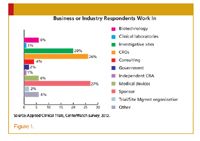
Figure 1.
For the time period January 2011 to July 2011, thepharmaceutical industry shed 18,264 jobs and for the same period this year8,968. And while the reasons for job cuts were not cited by individualindustries in the early August Challenger, Gray & Christmas jobs report,the top five reasons for job-cutting across industries are: restructuring,closing, cost-cutting, economic conditions, and loss of contract.
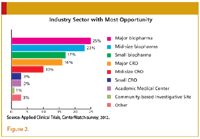
Figure 2.
However, while job cuts may be leveling off in thepharmaceutical industry, planned hiring is not in the cards. In the jobsreport, for industries planning to hire, pharmaceuticals were in the bottomthree. In fact, in another report, earlier this year, smaller to mid-sizebiotech companies were the ones more likely to predict growth versusone-third of larger companies. In an Aon Hewitt report, less than 5% of thesmall- to mid-sized biopharma companies expected their staffing to decrease,compared to 15% of the larger sponsors.
With all of the downsizings, and seemingly less or non-growingstaff to handle the workload, the larger pharmaceutical companies are taskedwith merging internal capacities, weeding out redundant departments andpositions, and figuring out what to do with the capabilities in which theywill no longer invest. Among these companies, outsourcing is the key togetting work done.
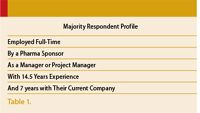
Table 1.
In a January 2012 Annual Global CEO Survey fromPriceWaterhouseCoopers, it found that 43% of biopharma CEOs had outsourced abusiness process function in 2011. This compares with all other industries,where CEOs reported 35% to the outsourced business function question.
In a survey that Applied Clinical Trialsconducted in August, results found the following top threeoutsourced functions: full-service CRO, 41.3%; monitoring, 21.7%; andsubject recruitment, 13%.
All of this outsourcing activity translates into additionaldownstream trends. The first is the ability of both the sponsor and itsoutsourced partner to effectively manage the outsourced relationships. Andsecond, is that it could mean a boon of sorts to contract researchorganizations.
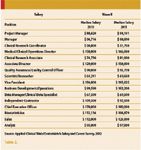
Table 2.
Both trends come to light in separate surveys. The first weconducted in August, where we asked: "Has your need to provideoversight of these sourcing relationships changed over the last twoyears?" The responses were weighted toward a definite increase at 62%.
And the second trend, what it means to CROs, the Salary andCareer Development Survey conducted in September and October by CenterWatchand Applied Clinical Trials found that respondents workingfor CROs were significantly more likely to see a positive change in theeconomy compared to sponsors or investigative site respondents.
In his September 2012 column, Ken Getz offered a more targetedanalysis of the CRO market size in the United States. From Tufts CSDD data,it surmised a total of 21,000 US jobs in the clinical research segment; 643total companies, and the total share of US personnel comprises 13%worldwide. Its analysis, which includes regulatory services, has theclinical research market valued at $6.5 to $8 billion. Approximately 17% ofthe companies providing these services are publicly traded.
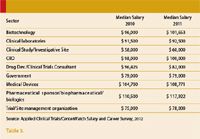
Table 3.
In other reports, the forecasts are for growth in global CROmarket size and penetration. Business Insights forecasts the market to be$35 billion next year, and Frost & Sullivan anticipates Compound AnnualGrowth Rate of 10.5% through 2017. William Blair & Co. expects thecurrent outsourcing penetration rate to increase by a few percentage pointsover the next year or two, and CRO management commentary suggests that overthe next five to seven years the outsourcing penetration percentage couldincrease to more than 60%. Its model currently anticipates a 10% increase inpenetration from 2010 through 2015. What this all means is that pharma isrelying on CROs and service providers more than ever in its clinicalresearch.
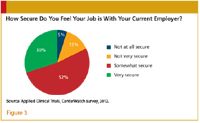
Figure 3.
Methodology
Applied Clinical Trials has conducted the Salary andCareer Development Surveys on a biannual basis since 2006. For our surveysin 2010 and 2012, we partnered with CenterWatch to develop the questionnaireand analysis of the data. Their own report from this shared data will bepublished in their January/February 2013 issue.
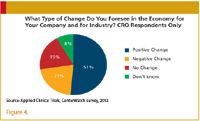
Figure 4.
The 2012 Salary and Career Development Survey was conductedduring the months of September and October 2012. The survey was conductedonline and was e-mailed to a broad range of clinical research professionalsworldwide (Figure 1). A total of 1,068 professionals responded to thesurvey. Close to three quarters of responses originated from the UnitedStates and the majority of the sample was employed full-time. A third of thesurvey respondents possessed a bachelor's degree as their highest levelof education completed and over half of the sample had some type of advanceddegree, indicating a highly educated group overall. Survey respondentsaveraged 15 years of experience in their profession and averaged seven yearswith their current employer (Table 1). The survey instrument contained avariety of questions relating to job satisfaction, job security, careerdirection, challenges in the work environment, and the economy's impacton careers and the clinical research industry in general.
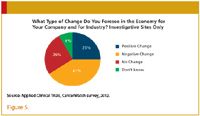
Figure 5.
According to the CenterWatch research analyst conducting thepast two surveys, the 2012 results were largely very similar to the 2010survey—the sample composition was generally the same as the lastsurvey in terms of industry/type of business/years experience and tenure atcurrent company. The following differences will be highlighted in thisarticle:
- Salary
- Job security
- Global trial challenges
- The economy
Salary
Overall, salaries have increased from 2010 to 2011. Theproportion of respondents who received supplemental income this past year isthe same as in the past survey.
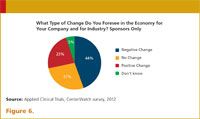
Figure 6.
Table 2 and Table 3 show the positions for which we surveyed,along with the increases between the two years. Also, we surveyed changes byindustry sector, illustrated in Figure 3. All in all, there were increasesto median salaries even with the negative economic news. For US regions, thelargest gainer was the Northwest, followed by the Midwest, Northeast,Southwest and the Southeast, where median salaries remained static.
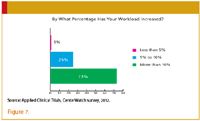
Figure 7.
Job security
With the losses and downsizings reported for the last threeyears, we asked respondents how secure they felt about their currentposition. Respondents in this year's survey were more optimistic aboutjob security compared to two years ago. A significantly higher proportion ofrespondents perceived their job security to have improved compared to twoyears ago (Figure 3). Once again, as with the overall economic view, whenlooking at the results by industry, respondents working for CROs weresignificantly more likely to respond that they were very secure in theircurrent jobs.
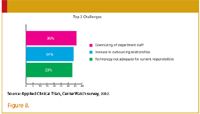
Figure 8.
For this response the changes between 2010 to 2012 werenon-existent. But, when asked about job security compared to three years agowith clinical research professionals in general, all respondents noted anuptick in the positive side of the spectrum.
By industry, 42% of CRO respondents felt very secure with theircurrent employer, versus 31% of site respondents and 18% of sponsors. Thesenumbers improved greatly when checking the "somewhat secure"rating to 46% for CROs, 55% for sites, and 60% for sponsors.
When asked about the security for clinical researchprofessionals for the past two years, the same industry sectors reportedsignificantly increased to 44% of CRO respondents; 35% for investigativesites; and 46% for sponsors.
Global trial challenges
There is no mistaking that clinical trials have gone global,with no signs of turning back. While the current distribution of clinicaltrials registered onClinicalTrials.gov features most trials still conducted in the United States, Europe,and Canada, the current value for the outsourcing market in China is peggedat $400 million.
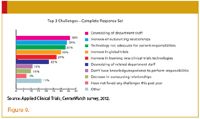
Figure 9
However, there has been noted concern that global trials are notall they are cracked up to be.
In Ken Getz's March 2012 column, he reflected on the rushto global trials as a panacea for faster enrollment numbers. However, theenrollment could be deceiving. As he wrote: "Sponsors and CROs havefocused on enrollment rates but less on setting up and coordinating theinfrastructure in remote regions to support these sites. One of the largestglobal CROs reported that on a recent pivotal trial it took three timeslonger to establish the infrastructure and work with health authorities andregulatory agencies in remote regions. A clinical supply manager recentlytold me that study drug shipping times to remote regions took up to twice aslong."
Getz also noted in a Tufts CSDD 2011 study that examined 16,000investigative sites participating in 155 global Phase II and Phase IIIclinical trials found the following:
- Eighty-five percent of all sites eventually achieved targetenrollment rates, however less than half did so within the planned clinicaltrial timeline.
- Fifteen percent took more than twice as long as planned.
- Eleven percent of global sites on average did not enroll a singlepatient.
Other surveys have shown that sponsors do have greaterchallenges in the shipping and logistics of the global clinical trial supplychain. Also, concerns exist regarding regulatory agencies in the UnitedStates and Western Europe acceptance of data from clinical trials inemerging markets.
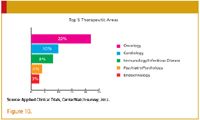
Figure 10.
Regardless of what sponsors are considering about global trialsat the higher levels, so far as our survey goes, the increase in globaltrials did not make the top three short list of challenges facing clinicaltrials professionals today. Nor has the increase in this specific challengeshown a change from the last survey, a mere 4% increase.
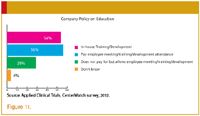
Figure 11.
However, when asked specifically if the professionals werefacing increasing, decreasing, or the same amount of challenges from globaltrials, the majority (46%) said it was increasing. Only 2% noted a decrease.The most significant challenges associated with the increase in globaltrials included the increased workload; changing regulatory requirements ormanaging various regulatory requirements; achieving global consistency; andtechnology challenges.
The economy
As mentioned, the economy has more than the actual financialeffect on the industry. The economic performance of a company leads to itschanging business strategies and operational practices to get more value andefficiency.
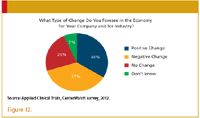
Figure 12.
As mentioned, the respondents from CROs more highly reported apositive change in the economy (Figure 4, Figure 5, and Figure 6). It couldbe from all the other factors listed above...an increase in outsourcing; anincrease in workload; a decrease in pharma staffing sizes. While wecan't pinpoint the reason from this survey, we hope that the positivefeelings spill over to the other market sectors and well into the next twoyears, when we conduct the next survey.
Check out Editor-in-Chief Lisa Henderson discussing the results of this Salary Survey: here
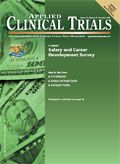
Improving Relationships and Diversifying the Site Selection Process
April 17th 2025In this episode of the Applied Clinical Trials Podcast, Liz Beatty, co-founder and chief strategy officer, Inato, discusses a number of topics around site engagement including community-based sites, the role of technology in improving site/sponsor relationships, how increased operational costs are impacting the industry, and more.
Behind the Buzz: Why Clinical Research Leaders Flock to SCOPE Summit
February 7th 2025In this episode, we meet with Micah Lieberman, Executive Conference Director for SCOPE Summit (Summit for Clinical Ops Executives) at Cambridge Innovation Institute. We will dive deep into the critical role of collaboration within the clinical research ecosystem. How do we bring together diverse stakeholders—sponsors, CROs, clinical trial tech innovators, suppliers, patients, sites, advocacy organizations, investors, and non-profits—to share best practices in trial design, program planning, innovation, and clinical operations? We’ll explore why it’s vital for thought leaders to step beyond their own organizations and learn from others, exchanging ideas that drive advancements in clinical research. Additionally, we’ll discuss the pivotal role of scientific conferences like SCOPE Summit in fostering these essential connections and collaborations, helping shape the future of clinical trials. Join us as we uncover how collective wisdom and cross-industry partnerships are transforming the landscape of clinical research.
FDA-Approved Gene Therapy Beqvez Shows Sustained Efficacy, Safety in Long-Term Hemophilia B Trial
April 17th 2025Beqvez (fidanacogene elaparvovec), an FDA-approved one-time gene therapy for hemophilia B, demonstrated sustained factor IX expression, low bleeding rates, and a favorable safety profile over long-term follow-up.